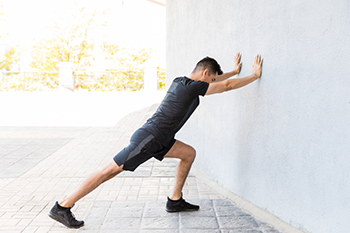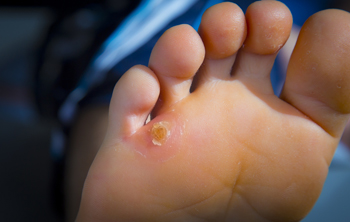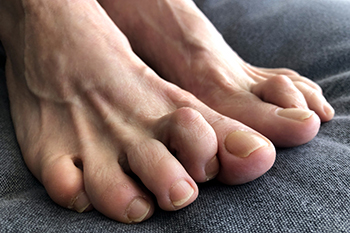
Cedarhurst (516) 374-3668
Franklin Square (516) 775-8440

Cedarhurst (516) 374-3668
Franklin Square (516) 775-8440

Foot injuries are common, especially for those who are active runners, but many can be prevented with proper care and attention. Plantar fasciitis, which causes heel pain, often results from overuse or inadequate footwear. Achilles tendinitis occurs when the Achilles tendon becomes inflamed, typically from repetitive stress or tight calf muscles. Stress fractures in the foot can develop from overtraining or improper footwear, while shin splints cause pain along the shin due to overuse. Metatarsalgia refers to pain in the ball of the foot, often caused by high-impact activities. Preventing these foot injuries involves wearing appropriate footwear, warming up before running, strengthening the muscles, and avoiding overuse. Stretching, maintaining a healthy weight, and gradually increasing activity levels also help protect the feet from strain and injury. If you have sustained a foot or ankle injury from running, it is suggested that you contact a podiatrist who can treat various foot conditions, and guide you on additional prevention tips.
Exercising your feet regularly with the proper foot wear is a great way to prevent injuries. If you have any concerns about your feet, contact Robert Stein, DPM of South Shore Foot Care. Our doctor will treat your foot and ankle needs.
How to Prevent Running Injuries
Many common running injuries are caused by overuse and overtraining. When the back of the kneecap starts wearing out and starts causing pain in your knee, this is commonly referred to as runner’s knee. Runner’s knee is a decrease in strength in your quadriceps and can occur if you’re not wearing properly fitted or supporting shoes. To prevent runner’s knee, focusing on hip strengthening is a good idea, as well as strengthening your quads to keep the kneecaps aligned.
What Are Some Causes of Running Injuries?
- One cause of a common running injury is called iliotibial band syndrome.
- Plantar fasciitis is also another common injury.
- Stress fractures can occur from overtraining, lack of calcium, or even your running style.
Best Ways to Prevent Running Injuries
- Wear footwear that fits properly and suits your running needs.
- Running shoes are the only protective gear that runners have to safeguard them from injury.
- Make a training schedule. Adding strengthening exercises as well as regular stretching can help keep you strong and limber and can lessen the possibility of injuries.
- Stretching keeps muscles limber; this will help you gain better flexibility.
If you have any questions please feel free to contact our offices located in Cedarhurst and Franklin Square, NY . We offer the newest diagnostic and treatment technologies for all your foot and ankle needs.

Achilles tendon injuries, including strains, tendinitis, tears, can cause pain and stiffness at the back of the ankle. These injuries often result from overuse, sudden increases in activity, or tight calf muscles. Athletes, runners, and people who spend long hours on their feet are particularly at risk. Strengthening and stretching exercises can help support recovery and prevent future injury. A simple calf stretch can improve flexibility and reduce tendon strain. Standing facing a wall, placing one foot forward, and pressing the hands against the wall while keeping the back leg straight can help loosen tight muscles. Eccentric heel drops strengthen the Achilles and calf muscles by lowering the heels slowly below a step and then rising back up. Toe raises, where you lift onto your toes, hold briefly, and slowly lower, build strength in the lower leg. For persistent Achilles tendon pain, it is suggested that you consult a podiatrist for proper care.
Achilles tendon injuries need immediate attention to avoid future complications. If you have any concerns, contact Robert Stein, DPM of South Shore Foot Care. Our doctor can provide the care you need to keep you pain-free and on your feet.
What Is the Achilles Tendon?
The Achilles tendon is a tendon that connects the lower leg muscles and calf to the heel of the foot. It is the strongest tendon in the human body and is essential for making movement possible. Because this tendon is such an integral part of the body, any injuries to it can create immense difficulties and should immediately be presented to a doctor.
What Are the Symptoms of an Achilles Tendon Injury?
There are various types of injuries that can affect the Achilles tendon. The two most common injuries are Achilles tendinitis and ruptures of the tendon.
Achilles Tendinitis Symptoms
Rupture Symptoms
Treatment and Prevention
Achilles tendon injuries are diagnosed by a thorough physical evaluation, which can include an MRI. Treatment involves rest, physical therapy, and in some cases, surgery. However, various preventative measures can be taken to avoid these injuries, such as:
If you have any questions please feel free to contact our offices located in Cedarhurst and Franklin Square, NY . We offer the newest diagnostic tools and technology to treat your foot and ankle needs.

Corns, or hyperkeratosis, are thickened patches of skin that often develop on the feet due to various factors, with age being a primary contributor. As people age, changes in foot structure, joint alignment, and foot function can lead to altered gait patterns, increasing the risk of corn formation. Ill-fitting socks and shoes are also common causes. Loose socks can cause friction, while tight socks irritate the skin. Shoes that are too tight or too loose, particularly high-heeled or narrow shoes, can create localized pressure, leading to corns. Obesity can affect weight distribution and gait. This leads to foot deformities like flat feet or excessive pronation, which can also predispose individuals to corns. Structural issues like hammertoes or bunions can worsen the problem. Treatment varies based on severity and location. A podiatrist may use debridement to remove thickened skin or perform surgery in more advanced cases. Corticosteroid injections may also help with pain. If you are experiencing corn pain, it is suggested that you make an appointment with a podiatrist for proper care.
If you have any concerns regarding your feet and ankles, contact Robert Stein, DPM of South Shore Foot Care. Our doctor will treat your foot and ankle needs.
Corns: What Are They? and How Do You Get Rid of Them?
Corns can be described as areas of the skin that have thickened to the point of becoming painful or irritating. They are often layers and layers of the skin that have become dry and rough, and are normally smaller than calluses.
Ways to Prevent Corns
There are many ways to get rid of painful corns such as wearing:
Treating Corns
Treatment of corns involves removing the dead skin that has built up in the specific area of the foot. Consult with Our doctor to determine the best treatment option for your case of corns.
If you have any questions please feel free to contact our offices located in Cedarhurst and Franklin Square, NY . We offer the newest diagnostic and treatment technologies for all your foot and ankle needs.

Hammertoe is a deformity that affects the toes, causing them to bend downward at the middle joint, resembling a hammer. It typically occurs in the second, third, or fourth toes and can be caused by a variety of factors. One of the primary causes is wearing tight or ill-fitting shoes that force the toes into unnatural positions. Other contributing factors include muscle imbalances, injury, and certain medical conditions like arthritis. There are two main types of hammertoe, flexible and rigid. In flexible hammertoe, the toe can still be moved, whereas in rigid hammertoe, the joint becomes fixed in a bent position. The symptoms of hammertoe include pain or discomfort when wearing shoes, visible bending of the toe, calluses or corns on the top of the toe, and difficulty walking. If you have developed a hammertoe, it is suggested that you consult a podiatrist who can offer effective relief options, helping you to manage this condition.
Hammertoe
Hammertoes can be a painful condition to live with. For more information, contact Robert Stein, DPM from South Shore Foot Care. Our doctor will answer any of your foot- and ankle-related questions.
Hammertoe is a foot deformity that affects the joints of the second, third, fourth, or fifth toes of your feet. It is a painful foot condition in which these toes curl and arch up, which can often lead to pain when wearing footwear.
Symptoms
Causes
Genetics – People who are genetically predisposed to hammertoe are often more susceptible
Arthritis – Because arthritis affects the joints in your toes, further deformities stemming from arthritis can occur
Trauma – Direct trauma to the toes could potentially lead to hammertoe
Ill-fitting shoes – Undue pressure on the front of the toes from ill-fitting shoes can potentially lead to the development of hammertoe
Treatment
Orthotics – Custom made inserts can be used to help relieve pressure placed on the toes and therefore relieve some of the pain associated with it
Medications – Oral medications such as anti-inflammatories or NSAIDs could be used to treat the pain and inflammation hammertoes causes. Injections of corticosteroids are also sometimes used
Surgery – In more severe cases where the hammertoes have become more rigid, foot surgery is a potential option
If you have any questions please contact our offices located in Cedarhurst and Franklin Square, NY . We offer the newest diagnostic and treatment technologies for all your foot and ankle needs.
Every patient is unique and so are treatments. The information on this website is for educational purposes and each individual
patient care model may differ.